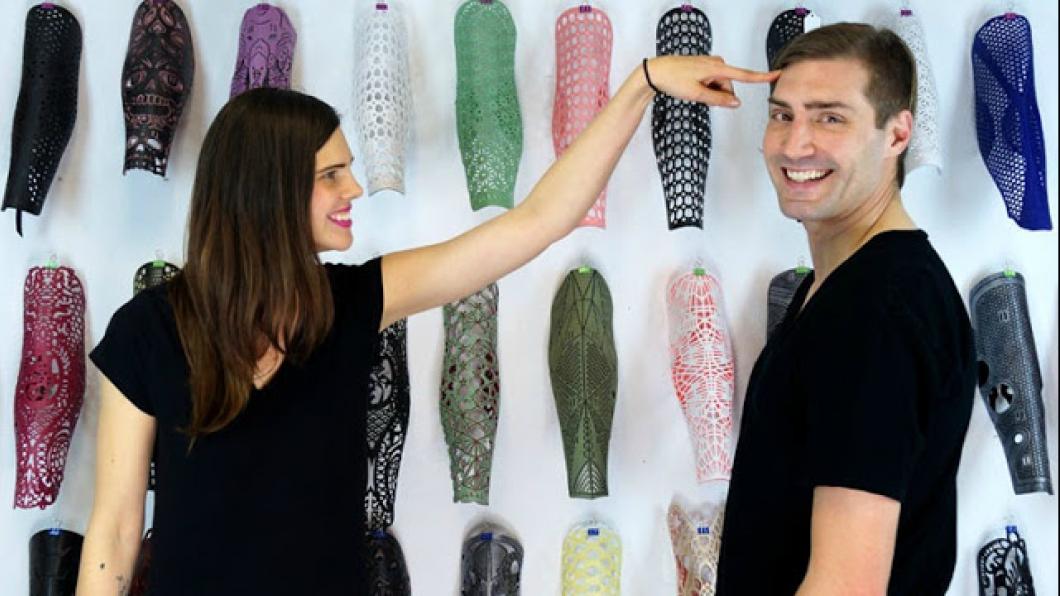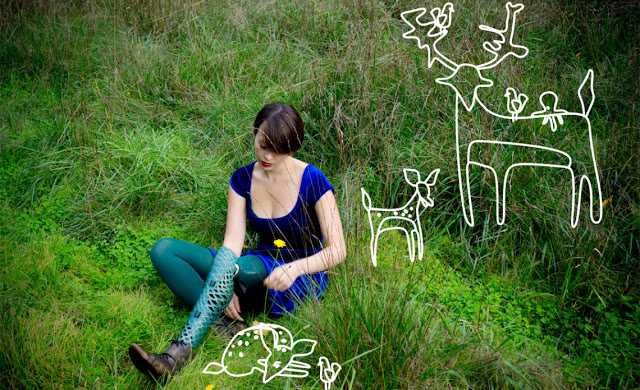
A prosthesis, and a work of art
By Megan Jones
In 2013, McCauley Wanner and Ryan Palibroda did what stereotypically passionate artists are wont to do: they quit their jobs, sold their cars, and moved across the country to pursue a dream. But their story wasn’t a cliché. McCauley and Ryan were working on an unconventional art project—a series of bright, fashionable covers for prosthetic legs.
The undertaking had begun in 2010 as a university project. At the time, McCauley was completing her masters in industrial design at the University of Calgary. While she’d decided to turn her attention to medical design, she was determined to incorporate her long-held interest in fashion into her work.
A friend introduced her to John-Paul Austring, a fellow U of C student who had lost his leg to cancer at the age of 16. The two began talking about prosthetics, and the aesthetic options available to those who wore them. During her conversations with John-Paul and other amputees, McCauley quickly realized there weren’t many choices. “The more people I talked to the more I realized there was nothing,” she says. “It was shocking.”
She decided to take matters into her own hands, and dedicated her thesis to imagining what fashionable prosthetic covers might look like. After she finished school she joined with Ryan, who’d recently completed his masters of architecture. He worked on the practical, physical designs. Combining their skills, the pair soon began developing their own real-life models.
Today, the project has grown into Alleles, a Victoria, B.C.-based company that produces the bold prosthetic covers long envisioned by McCauley, now 30, and Ryan, 35. “An Allele is a biology term meaning a mutation of a gene responsible for causing variation like hair colour, eye colour, or smooth as opposed to wrinkly,” McCauley says. “Our company is all about providing variety to showcase variety.”
Their devices, which are made from plastic, attach to prostheses using a strapping mechanism. Since launching in October 2013, Alleles has produced around 1,000 of them.
Ready-to-wear covers are generally priced between $325 and $500 (custom models cost more—for example, some buyers have requested designs that feature tattoos they’ve lost along with their limbs). From the beginning, affordability was a key concern for McCauley and Ryan. They’d seen very few fashionable prosthetics online, and those that existed were typically elaborate art projects that cost thousands of dollars.
“We designed it be a retail product,” Ryan says. “We wanted people to actually be able to buy them.”
While the pair currently dedicates nearly 12 hours a day to working with and for amputees, prior to starting the project, McCauley and Ryan had very little experience with disability. In a way, this was an asset, they say. Being outside the industry meant they didn’t have preconceived notions about how prosthetics should be made, which allowed them to take more risks.
“It often seems like in medical design, people are concerned with getting their clients to function again in the setting of a hospital or clinic,” McCauley says. “But they don’t really think about that person living their life in the real world on a daily basis.”
“As outsiders we got to ask ourselves, ‘Why doesn’t this have any soul in it, why doesn’t this have any heart?’”
In order to make up for their lack of prior knowledge, the Alleles team made sure to consult closely with amputees, who talked about what they wanted and needed from their prosthetics.
One of those people was John-Paul. Since meeting McCauley during their university days, the now-29-year-old has stayed connected to the project and regularly gives feedback on their products. He has five covers of his own, and wears his current favourite 24/7, only removing it when it needs to be washed.
When he first lost his leg, John-Paul was given a bulky plastic cover, which created strange, unnatural-looking contours under long pants. He was embarrassed about how he looked, but felt hesitant to speak with his prosthetist, fearing he’d be seen as frivolous.
By contrast, he says, the Alleles covers feel like an empowering form of personal expression. “A prosthetic is a medical, utilitarian device,” he says. “It’s something that’s done to you. With these covers though, you’re turning the tables.”
John-Paul feels a sense of pride when he wears his covers, and a willingness to embrace his disability.“People don’t choose to lose limbs or get prosthetics,” he says. “But now you can choose to put something artful and beautiful on it. That becomes part of the healing process.”
Best of all, he says, the intricate designs have changed the way strangers interact with him. In the past, he says, people would stare at his missing limb, or ask him prying, personal questions about what happened to his leg. He felt singled out, objectified. And most days, he had no desire to rehash the painful experience of having cancer with people he barely knew.
With the covers though, the conversation shifted. Suddenly, people were complimenting him on the exciting designs. He could talk about his style, rather than his prosthetic. It was a much better icebreaker.
“Some days, I still struggle with the idea that my disability is a sign of weakness to others,” he explains. “This cover helps me get away from that. It shows I’m owning my disability.”
***
There’s a reciprocity between the Alleles designers and their customers. Just as people like John-Paul are influenced by the covers, individuals who wear Alleles products inspire McCauley and Ryan, who often name their designs after significant people or events. John-Paul has inspired two titles, with one cover bearing his first name, and another, his middle name, Steen.
In the future, McCauley and Ryan hope to expand their collaboration beyond individual customers. They’re hoping to partner with larger companies to become more visible in the mainstream fashion world. A brick and mortar store is also in the works. The couple plans to open up a boutique where customers can come to browse and get fitted. Ultimately, they’d like to include a line of clothing that would complement their covers as well. To them, this blending of fashion and disability is crucial.
“What people don’t understand sometimes is that everyone—regardless of ability—cares about how they look,” Ryan says. “Everyone has a way they want the world to see them.”

